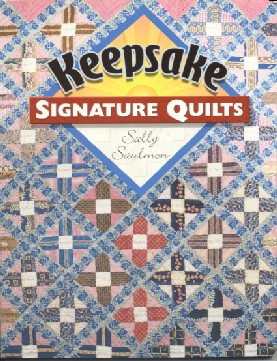|
 When color and lightfast ink -- called indelible ink -- was finally produced, the
fad for signing one's name on fabric began. Women signed quilt blocks to
combine them into quilts as goodbye memories to those moving westward. The
signature quilt fad lasted quite a long time -- from 1840 through the1870s.
A more fast ink came into use around 1835, but the expansion westward is what
actually brought about the desire for signing quilts like autograph books. It
gives me pause each time I remember that westward expansion at that time could
be a move from Massachusetts to Ohio! The far western states were still a journey
far too treacherous for most families to undertake. The lure of California in
the early 1850s, changed the minds of many who were then willing to come
across the mountains
and wilderness to find their riches. Research tells us few quilts were actually
made while on this long and difficult journey, but many were brought along to keep them warm
and use in their new homes. When color and lightfast ink -- called indelible ink -- was finally produced, the
fad for signing one's name on fabric began. Women signed quilt blocks to
combine them into quilts as goodbye memories to those moving westward. The
signature quilt fad lasted quite a long time -- from 1840 through the1870s.
A more fast ink came into use around 1835, but the expansion westward is what
actually brought about the desire for signing quilts like autograph books. It
gives me pause each time I remember that westward expansion at that time could
be a move from Massachusetts to Ohio! The far western states were still a journey
far too treacherous for most families to undertake. The lure of California in
the early 1850s, changed the minds of many who were then willing to come
across the mountains
and wilderness to find their riches. Research tells us few quilts were actually
made while on this long and difficult journey, but many were brought along to keep them warm
and use in their new homes.
Sally Saulmon put an 1847 quilt on the cover of her book, Keepsake Signature
Quilts, which is reason enough to buy this book. The blue fondue sashing and
Turkey red prints are so beautiful together with the steam colors in the printed plaids, indigos, browns and buff stripes. I found the interior of the
book visually enticing as well. Sally has used new reproduction fabrics to make
her sample quilts and blocks throughout the book, as well as contemporary
fabrics. She uses reproduction shirtings, stripes, serpentines, large and
small florals, indigos, 30s prints, rainbow prints, and tone-on-tone calicos in
striking and intriguing ways. The settings and quilts on her samplers offer
more to the quiltmaker than just the pattern. She helps you to look at your
fabric differently and the results are beautiful.
There are 24 different patterns in the book. For some, the actual quilt is
shown in a full shot, with a detail shot of the block. The colors are
clear and the fabric's design is easy to make out. Rotary cutting instructions
with diagrams accompany each pattern. Sally makes it easy to use each pattern.
 Beginners will have no problem using many of the patterns in
the book. The
addition of signatures or sayings makes the simplest block, like rail
fence, unique. The more advanced quiltmaker will appreciate her use of fabric
to enhance blocks with which they are already familiar. Beginners will have no problem using many of the patterns in
the book. The
addition of signatures or sayings makes the simplest block, like rail
fence, unique. The more advanced quiltmaker will appreciate her use of fabric
to enhance blocks with which they are already familiar.
Sally correlates the fabric's print with the mood or occasion set by the
signature or saying. By adding multi-pieced strips and turning simple signature
blocks on-point, quilts look more complex. She likes the
scrap approach and uses many fabrics in one or two main color tones in a quilt.
She has a very good eye for arrangement and value.
Sally offers the reader information on various signature and text marking techniques. She describes seven methods, ranging from
pens, to machine embroidery, to copiers. Most of her samples have names, cities, or a sentence of friendship. She
also gives some valuable information on how to make and conduct a group
signature quilt project. You will find her tips
helpful.
This book offers more than signature methods as the name implies -- 112 friendly
pages draw you in and help you make use of your repro stash fabrics in
new ways, fast and easy.
Click here for more information about
Signature and Album quilt
history.
Book publishers and authors: if you would like your book
reviewed on this Website, and it falls within the scope of topics, please
contact me. |